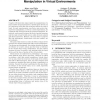2096 search results - page 110 / 420 » Structured Parameter Elicitation |
BMCBI
2006
14 years 10 months ago
2006
Background: The accuracy of protein secondary structure prediction has been improving steadily towards the 88% estimated theoretical limit. There are two types of prediction algor...
CVPR
2008
IEEE
15 years 12 months ago
2008
IEEE
Given a finite number of data points sampled from a low-dimensional manifold embedded in a high dimensional space together with the parameter vectors for a subset of the data poin...
124
click to vote
TFS
2008
14 years 9 months ago
2008
Abstract--This study proposes an efficient self-evolving evolutionary learning algorithm (SEELA) for neurofuzzy inference systems (NFISs). The major feature of the proposed SEELA i...
VRST
2006
ACM
15 years 3 months ago
2006
ACM
Complex 3D interaction tasks require the manipulation of a large number of input parameters. Spatial input devices can be constructed such that their structure reflects the task ...
CSB
2005
IEEE
15 years 3 months ago
2005
IEEE
Searching genomes for RNA secondary structure with computational methods has become an important approach to the annotation of non-coding RNAs. However, due to the lack of effici...

